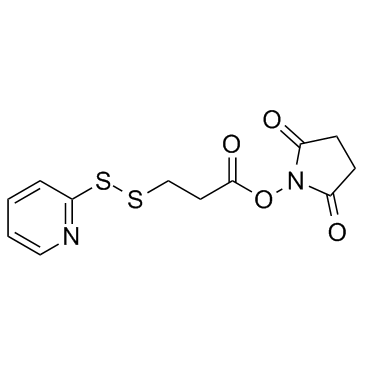SPDP (SPDP Crosslinker) |
| Catalog No.GC30018 |
SPDP (SPDP Crosslinker) (SPDP (SPDP Crosslinker) Crosslinker) is a short-chain crosslinker for amine-to-sulfhydryl conjugation via NHS-ester and pyridyldithiol reactive groups that form cleavable (reducible) disulfide bonds with cysteine sulfhydryls. It is a glutathione cleavable ADC linker used for the antibody-drug conjugates (ADCs).
Products are for research use only. Not for human use. We do not sell to patients.

Cas No.: 68181-17-9
Sample solution is provided at 25 µL, 10mM.
SPDP is a short-chain crosslinker for amine-to-sulfhydryl conjugation via NHS-ester and pyridyldithiol reactive groups that form cleavable (reducible) disulfide bonds with cysteine sulfhydryls. equal amounts of anti-CD11c and anti-CTLA-4 Abs (in borate buffered saline; pH 8.5) were activated using SPDP .
[1]. Lobedanz S et al. A periplasmic coiled-coil interface underlying TolC recruitment and the assembly of bacterial drug effluxpumps. Proc Natl Acad Sci U S A, 2007 Mar 13, 104(11):4612-7. [2]. Karumuthil-Melethil S et al. Dendritic cell-directed CTLA-4 engagement during pancreatic beta cell antigen presentation delays type 1diabetes. J Immunol 2010 Jun 15, 184(12):6695-708.
Average Rating: 5 (Based on Reviews and 39 reference(s) in Google Scholar.)
GLPBIO products are for RESEARCH USE ONLY. Please make sure your review or question is research based.
Required fields are marked with *




















